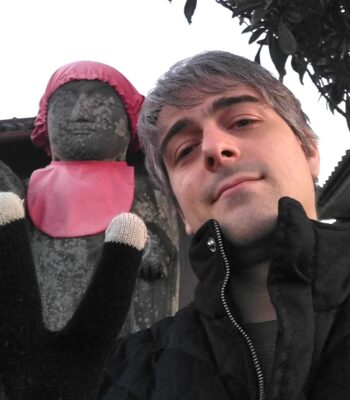- Learning Japanese
- Japanese Culture
Before You Learn a Single Word of Japanese, Read This
2025.06.19

Introduction: This Isn’t Another “How to Learn Hiragana” Article
I know what you’re expecting to hear. “First you learn Hiragana, then Katakana, then basic Kanji, then you use Anki flash cards”, etc. Frankly, that’s not what you need to hear anymore, nor what this article is about.
You already know that you need to learn Hiragana and Katakana first, and have already learned most of them if not all of them through an assortment of Japanese starter apps and youtube videos.
I’m going to introduce you to something today you didn’t realize you needed, but will change your life forever and absolutely revolutionize the way you learn Japanese.
I’m going to show you something that will make you learn faster, better, and guarantee success in all your endeavors. This is my secret 5 step method I’ve painstakingly cultivated through years of trial, error, and research that even the best Japanese teachers don’t teach, or even think about themselves.
This is the untold prequel of how to start learning Japanese.
Step 1: Create a Vision That Actually Motivates You

“Vision? What? I didn’t want a philosophy lesson, just teach me how to learn Japanese”. I know I know, hold your horses and just hear me out real quick.
I’m sure you’d like to hear “Omg Japanese is so easy just use this super secret learning method and you’ll be fluent in a year”. Sadly, this is not the case, unless you are an incredibly rare foreign language savant.
The reality is that learning Japanese is not easy, and takes steady dedication over a long period of time to make any noticeable amount of progress.
This is why most people give up midway and not only lose all the progress they made, but stop just before they can actually start reaping the real benefits of learning Japanese.
What most people do is comparable to rebounding on a diet; they do well for a little while, lose weight, and get in relatively decent shape, but then lose motivation, stop working out, and gain all the weight back. I don’t want you to rebound.
I want you to unlock the hidden treasure that is Japan, and reap all the wondrous benefits it will give you. And to do this, you need a vision. In a few words, having a tangible vision for the end goal of your Japanese learning Journey is the number one thing that will keep you staying focused, motivated, and prevent you from rebounding.
So, how does one go about creating a truly good vision, and what are the conditions for a truly good vision? Glad you asked. To start, you need to ask yourself the following questions:
-
-
- Why do I want to learn Japanese?
- What do I want to achieve by learning Japanese?
- What does the me in 10 years look like using Japanese? How, where, and with who am I using it with?
-
Now that you’ve got a conceptual answer to these questions, utilize the power of image training to create a tangible, mental image that represents your answers to these questions.
It doesn’t need to be anything extravagant or complicated, in fact simpler is better. It could be a scene of you writing a letter completely in Japanese to your very first Japanese professor.
Or it could be you talking effortlessly in Japanese with a Japanese language partner of yours that you know very well and knows how far you’ve come. Or it could be you sitting in a chair in your new modern apartment in Japan, reading a manga you read many years ago in English but now you can read it all in Japanese.
The important thing is that the vision meets the following conditions:
The vision is so tangible and concrete that you can almost feel it
The vision contains objects, places, and people that all have very significant, emotional meaning to you. (note; the objects, places, or people don’t necessarily need to be things or people from your current environment)
The vision is a visual manifestation of your truest, deepest desires surrounding learning Japanese. Don’t be shy or embarrassed, this is completely subjective, so don’t be afraid to make it about what you truly want.
This vision and goal will act as your compass, and keep you from falling off the path. It will center you, guide you, provide motivation, and give you a sense of unease when you start to stray off the path.
Step 2: Break Down Your Vision into Macro and Micro Goals

Now that you have a solid vision you’re happy with, it’s time to break down the actual requirements for achieving your vision.
Start by writing very general, high level bullet points of just the simple things you know now to break down your vision into more tangible goals.
So as an example, if someone’s vision was “to speak conversational Japanese”, you might break that down into macro level goals such as “Learn up to pre-advanced Japanese sentence structure”, “Perform regular listening practice in order to pass the listening portion of the N2 JLPT exam”, “Achieve Speaking ability through consistent conversation practice” “Achieve intermediate level understanding of Japanese writing system”, and so on.
Once you’ve written your macro level goals down, it’s time to break each of them down to sub requirements to make each high level bullet point a reality step-by-step.
Let’s take the first “ Perform regular listening practice in order to pass the listening portion of the N2 JLPT exam” goal as an example and try breaking this down into tangible steps:
NOTE: Make sure to do extensive research before you start writing sub requirements. You can write the macro level goals relatively easily with minimal research or background knowledge, but it takes much more sifting through and learning new information to make meaningful sub requirements for each high level goal.
Stage 1: Absolute Beginner (JLPT N5)
- Slow, clearly enunciated sentences with furigana, subtitles, or a script.
- Short, basic dialogues: greetings, self-introductions, daily routines
- Audio from beginner textbooks (e.g., Genki I)
- Repetition-heavy audio like shadowing beginner phrases
Stage 2: Beginner–Lower Intermediate (JLPT N4)
- Slightly longer conversations using polite form (です・ます)
- Daily-life topics: shopping, weather, school, family
- Audio with basic verb conjugations, particles, and question patterns
- Listening with comprehension questions (textbook drills). It would still be preferable to have subtitles or a script at this level.
Stage 3: Intermediate (JLPT N3)
- Normal-speed simple dialogue using casual form + polite form
- Topics include travel, opinions, invitations, complaints
- Audio containing full conversations
- Exposure to spoken grammar structures: 〜てしまう, 〜ながら, 〜たほうがいい
- Simple Podcasts or short drama scenes with clear articulation, along with JLPT N3 mock listening exams and listening exercises
Stage 4: Upper Intermediate–Pre-Advanced (JLPT N2)
- Normal-paced daily conversations with natural intonation
- Exposure to formal, polite, casual, and honorific/humble language
- Complex grammar in real speech: 〜わけではない, 〜くせに, 〜ように
- Non-explicit questions (listening for intent, implied meaning)
- Real-world listening: TV dramas, variety shows, native interviews
- Full JLPT N2 timed mock exams and JLPT listening exercise books
If you do this for each of your macro goals, you should now have a solid outline and sense of direction on how you are going to go acquire the Japanese skills to meet your goal.
However, naturally there are pitfalls; without any guidance, it is very easy to write down sub requirements that don’t get you to your goal when you’re new and don’t know what you’re doing.
There is a mountain of conflicting information on the web from different people, and it’s oftentimes incredibly hard to find and really understand the requirements that actually make you succeed.
Anyone can write requirements into a pretty outline that looks good on paper, but very few can make one that rockets you straight to your goal.
I can’t stress it enough; quality over quantity. Whatever you write, make sure it is very well backed by logic, research, and preferably several professional opinions.
Taking a little bit more time on the front end to write truly high quality requirements can save you months, even years of unnecessary floundering not achieving your end goal in the future.
If you’re struggling to write your high level goals and sub requirements, don’t worry; Oku Sensei is incredibly talented, skilled, and experienced when it comes to building plans for students, and can absolutely help you in making a truly meaningful one.
Once you’ve completed your list of goals and sub requirements, you should have a solid, comprehensive list that can give you a much better tangible sense of what you need to actually do in order to make your vision a reality.
If you’re interested in a Roadmap for Japanese grammar, check out the following article:
Step 3: Create a Realistic, Chronological Study Plan

Now that you have an outline of where you're going and how you’re going to get there, it’s time to expand that outline into a chronological plan.
By far, the biggest and most common mistake people make with this is underestimating how long it takes to get proficient in Japanese. Don’t worry, it’s not your fault. You’ve been birraged with video after video of random people on the internet telling you how easy Japanese is and how they just casually studied some textbooks and became conversationally fluent in a year.
So naturally, you’d think that you should be fluent in a year with minimal effort. Unfortunately, these people are either lying to you to inflate their own ego or extreme exceptions, and 99% of people, even very talented and intelligent people cannot do this (trust me I’ve lived through it).
Whatever plan you make, it should be an overall span of several years, not months. To put this in perspective; I studied like a mad man while Oku Sensei helped rocket me to conversational fluency as fast as functionally possible, and even then it took me 4 years.
If you are extremely naturally gifted, have tons of money and time, and can live in Japan going to a really good quality Japanese language school with a great private tutor? Ok yeah maybe 1 - 2 years is possible.
But if you’re not living in Japan right now and need to start from scratch and don’t have all the money and time in the world? Definitely going to take you longer than 1 - 2 years. Learning Japanese is a life changing experience, and major life changes take time to implement.
Think about it; you need to learn while not in Japan and can only devote so much time, money, and energy to it with your current lifestyle. Then if you want to move to Japan?
How are you going to get there? Once you get there, how are you going to support yourself? If you don’t go to Japan, how will you consistently grow your Japanese skills? Are you going to use your future Japanese skills to boost your income, and if so how?
There are an incredible amount of logistics that need to be worked out along with just learning the language itself, so accept from the beginning that progress is not going to be as fast as you’d like.
Don’t hold unrealistic expectations, and just solely focus on mastering the basics; have a plan that works, stick to the plan, and evaluate yourself periodically to see if you are more or less making the progress you should be.
The next most important thing with making a plan is breaking down things into themed phases. The core function of dividing your plan into phases is to give yourself short term checkpoints that keep you motivated and make your progress tangible. Important things to make sure your phases contain are:
An overarching description that captures the essence of all the requirements in the phase as well as a tangible idea of where you will be at the end of it.
For example, you could set a beginner phase with an overarching description of “phase for learning Japanese hiragana, katakana, first essential 100 Kanji, and listening, speaking, reading, and writing of simple practical use conversations”. In one sentence, you should be able to summarize the gist\theme of what you will do and achieve in that phase.
Offers a satisfying sense of completion at the end. In order to get a satisfying sense of completion, you need to have some way of tangibly evaluating your own level at the end of each phase.
Of course, one of the best ways of doing this is taking the JLPT exams, but if your goal is not to master the language or pass all levels of the JLPT, that is also fine. As long as you have something concrete to evaluate your progress, that should suffice.
For example, a good pre-intermediate goal could be something like “Be able to read a 5 line paragraph in “yasashi nihongo” and understand at least 80% of the content.
Each phase is not overly long. A major pitfall people will fall into is splitting the phases into beginner, intermediate, and advanced. In the case of Japanese, the intermediate and advanced levels are far too vast to cover in just one phase each.
This is one of the biggest causes for people losing motivation. At the very least, dividing “intermediate” into pre-intermediate, intermediate, and advanced-intermediate would make each phase a much more digestible chunk that will keep you motivated to keep going in the long run.
These phases will be the supporting pillars of your vision; without them, the possibility that you will start losing motivation, get disheartened, give up increases exponentially.
★Also try reading: What Excellent Japanese Speakers Know That Most Don’t: Top 8 Secrets
Step 4: Organize Your Finances, Job, and Living Situation

Noone ever sat me down and talked about this, but I wish someone had. I cannot stress how important this is.
Without evaluating these three things before and after you create a plan to learn Japanese, you are guaranteed to run up against a wall at some point.
Borrowing the words of Ramit Sethi, you must first define what your “rich life” is. This does not mean having an extravagant amount of money, nor living in an enormous mansion, nor driving an $100,000 car. This is all about prioritizing, cutting costs on things that don’t matter to you, and investing in only the things that you truly care about.
This might sound like common sense, but shockingly, most people are not actually doing this. How many automatic payments do you have on your credit card that you “feel like you need”, but in reality could easily live without?
What about that brand new car you just bought that is costing you $450 a month out of pocket ? Did you truly “need” that car? Is it making your life more fulfilling? If your biggest dream in life is to live in an enormous mansion, or drive a fancy car, then go right ahead.
However, if living in a big house or driving a fancy car doesn’t matter to you very much, you shouldn’t be investing in those things. You shouldn’t be buying that brand new car because “it would be nice to have”, nor should you be getting a mortgage on a house because “it’s what everyone else is doing”.
If what you truly love is learning Japanese, you should be investing in it and cutting costs on everything else. It’s ok to drive an inexpensive used car. There is nothing wrong with paying rent for a small sized, modest apartment.
No you don’t need to get a mortgage because “you’re about that age now” and just got married. Don’t give into the social pressures of spending on what you “feel you should” or “feel is necessary”; invest only in the future you most desire.
Downsize your residence, switch to the inexpensive used car, cut out those payments that you “feel you need”, and work hard to get that job that pays you an extra $10 ~ $20k a year.
I guarantee that just by doing these things, you will quickly gain hundreds if not thousands of extra dollars a month of disposable income that you can use to invest in learning Japanese and achieving your “rich life” as you define it. Life is too short to spend it doing things that other people say you should do.
Ruthlessly cut unnecessary expenses, fight for that higher salary, and start investing in the future YOU want, not the one other people want for you.
Step 5: Face the Personal Obstacles Holding You Back

This is the elephant in the room. This is that nagging, personal problem that is constantly lurking in the background and silently dragging you down and ruining your potential right under your nose.
You know it’s a problem, or at least have a feeling that it could be pulling you back. It could be your boyfriend that is overall a good person, but just doesn’t care about you learning Japanese nor supports you learning it very much.
You enjoy his presence most of the time, and get along pretty well, but whenever you start talking about Japan or learning Japanese, he says slightly unsupportive things and subtly belittles your interest in the language.
Or it could be your parents. They want you to “get a real job” and go into some STEM field, and are pushing you into it because they are paying for your living expenses, tuition, or both. Or it could be those friends that you have a good time hanging out with, but are always subtly pushing you down and making you feel lesser than them.
You’ve been friends for years and grew up together, and definitely have plenty of fun and fond memories together. But deep in your heart, you know they don’t support you, and are only friends with you because it’s convenient and your presence makes them feel better about themselves.
I myself had many friends like this around me. When I first started studying Japanese, not one friend truly supported me, nor thought what I was doing would amount to anything.
Most of them looked down on me, and just said things like “Well, that’s weird but ok”, or “Why Japanese? What are you crazy?”.
If there is anything I can tell you from experience; I know how hard it is to solve these problems, trust be I’ve been through them many times.
It’s easy to brush them off and pretend that the problems don’t exist. You get good at laughing it off or acting like you don’t care when the people around you that should be the most supportive belittle you and put you down.
You can pretend like you're not hurt and totally fine; for a time that is. However, whether you like it or not, that problem is festering and growing slowly under the surface, and one day, whether you like it or not, this problem will come to the surface, and you will have no choice but to face it. I’m not going to lie to you; facing the problem is extremely painful.
Opposition is never comfortable, and change is uncomfortable for both you and the people around you. The more you grow and develop, the more they will get uncomfortable and oppose the change. But know that the sooner you rip off the bandaid and get it over with, the better. You will save yourself years of meaningless emptiness and dissatisfaction, and will be able to become the person you truly want to become much sooner than other people.
Some people never muster the courage to do this, and just live the life that makes everyone around them comfortable. If you want a truly satisfying and fulfilling life, don’t make any more excuses to yourself and face the elephant in the room right now.
The longer you put off facing the problem, the more it will fester, and the farther you will become from your dream of speaking Japanese and going to Japan.
Conclusion

Too many people fail at learning Japanese not because they lack discipline or drive—but because no one ever teaches them how to build a strong foundation before they even begin. They dive into grammar and vocab without a vision, without structure, and without asking the deeper questions that determine long-term success.
This article is about more than just a method—it’s about a mindset.
I challenge you to reflect, plan, and confront the realities that are holding you back: the lack of clarity, poor planning, financial pressure, unsupportive relationships, and unrealistic expectations.
But reading is just the first step. Implementation takes time. You might need weeks, months, or even years—to process everything in this article and start building the life and study system that supports your vision. And that’s okay. Don’t lose heart. Don’t give up. Take one piece at a time and move forward, strong and steady. That’s how real progress is made.
And when you feel overwhelmed—or when the world around you makes you doubt yourself—that’s exactly where OSJ can support you.
Our courses aren’t just built around a proven learning structure—they're built around you. Your goals, challenges, and your personal life situation. At OSJ, we don’t just teach—we walk with you and support you through all your trials and tribulations, both linguistic and emotional. Through the confusion. Through the setbacks. Through the moments you feel like giving up.
We’ve seen it all—from students battling external pressures to those quietly struggling with self-doubt behind the scenes. That’s why OSJ offers more than just technical instruction—we offer structure, life advice, and emotional support on your journey of learning Japanese.
Our courses are designed so that the plan is already clearly laid out for you, helping you remove logistical barriers and focus all your energy on learning effectively and staying emotionally grounded.
So if you're ready to move forward—we’ll be here when you need us.
👉 Explore OSJ’s courses and start building your future in Japanese.
Your journey doesn't have to be lonely.Let’s walk it together.


















